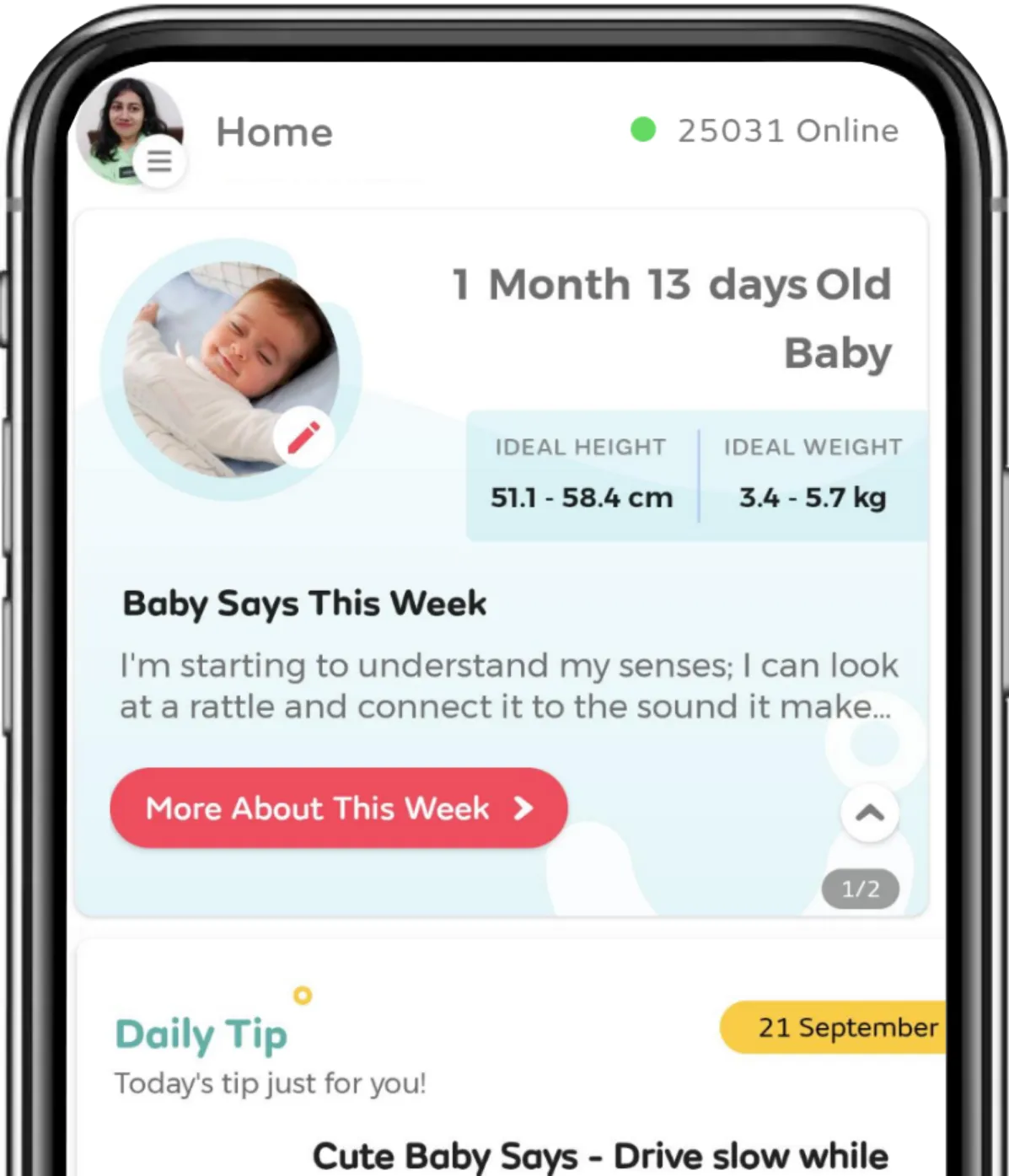Get MYLO APP
Install Mylo app Now and unlock new features
💰 Extra 20% OFF on 1st purchase
🥗 Get Diet Chart for your little one
📈 Track your baby’s growth
👩⚕️ Get daily tips

OR


Article Continues below advertisement
In this Article
- Your Guide to Breastfeeding in the First Year
- Month 1: Perfecting the Latch
- Month 2: Keeping Up With Your Milk Supply
- Month 3: Breastfeeding and Birth Control
- Month 4: Keeping Your Breast Milk Safe
- Month 5: Juggling Breastfeeding and Sleep
- Month 6: Introducing Solids
- Month 7: Familiarising Yourself With Pumping
- Month 8: Dealing With Clogged Ducts
- Month 9: Curbing the Biting
- Month 10: Losing Interest in Nursing
- Month 11: Balancing Breast Milk and Solids
- Month 12: Determining When to Wean
Feeding
The Ultimate Guide to Breastfeeding Your Baby for the Entire First Year
Updated on 27 February 2023



Medically Reviewed by
Kusum Sabharwal
Obstetrician & Gynecologist - MBBS| DGO
View Profile

The initial days and weeks of breastfeeding often come down to sheer survival: ensuring your baby latches onto (and stays on!) your breast; functioning on bare minimum sleep; and pushing yourself to hang in there even if you're having problems. Yet at some point down the line, when you and your little one have caught up with each other, you're likely to have different questions and concerns.
Your Guide to Breastfeeding in the First Year
Let us understand some of the common breastfeeding issues you might face during the first year and how to get through them.
Month 1: Perfecting the Latch
Without the right latch, your baby may not get enough milk, and you may develop sore and cracked nipples.
Article continues below advertisment
- Position your baby so they are lying on their side, their belly flush against yours.
- Prop up the baby with a pillow and hold them up to your breast; don't lean over toward them.
- Using your free hand, place your thumb and fingers around your areola (the pigmented area surrounding the nipple).
- Tilt your baby's head back slightly and gently touch them with your nipple just above their upper lip.
- When their mouth is open wide, scoop your breast into their mouth. Place their lower jaw on first, well behind the nipple.
- Tilt their head forward, placing their upper jaw deeply on the breast. Make sure they take the entire nipple and at least 1½ inches of the areola in their mouth.
You may also like: How To Feed A Newborn Baby By Breast?
Month 2: Keeping Up With Your Milk Supply
Milk supply is among the most common concerns breastfeeding moms have because unlike with a bottle, it's hard to tell how much milk your baby is consuming. To make sure you're both on the right track, your pediatrician will monitor your baby's weight closely, especially for the initial few months.
Month 3: Breastfeeding and Birth Control
Not ready for another little one yet? It's time to discuss breastfeeding-friendly birth control options with your doctor. You can try a progestin-only birth pill since pills containing estrogen can lower the breast milk supply.
Month 4: Keeping Your Breast Milk Safe
You might want to enjoy a glass of wine but your baby shouldn't. To make sure your breast milk is safe to consume for your baby, it's recommended that you avoid drinking alcohol while you're breastfeeding your baby. Any amount of alcohol in your bloodstream can enter the baby's body from your breast milk and harm them. As a result, continue to stay off alcohol as long as you're breastfeeding.
Month 5: Juggling Breastfeeding and Sleep
By the time your little one turns five months old, you may be sleep deprived and counting down the days until your baby can sleep through the night. But you need to keep in mind that at this age a baby sleeps at most for five or six hours, not eight or nine hours.
Article continues below advertisment
Month 6: Introducing Solids
As your baby is ready to hit another milestone and try solid foods it shouldn't mean that it's time to give up breastfeeding. Breast milk is still the most essential part of your baby's diet, so you should continue to breastfeed your baby.
When you do start solids, begin with sooji porridge and gradually add a cooked or mashed fruit or vegetable. It's best to wait 3-5 days before introducing a different food so that it's easier to identify an allergic reaction if there is one.
You may also like: 6 Signs Your Baby is Ready for Solid Foods
Month 7: Familiarising Yourself With Pumping
Many new moms return to work around this time. If you’re planning to continue breastfeeding, you will need to pump and store your breast milk to ensure your baby has enough to last while you're at work. You should also plan your childcare and develop a pumping routine to ensure things go more smoothly before you actually get back to work.
Month 8: Dealing With Clogged Ducts
Clogged milk ducts can be a painful and common breastfeeding issue. This could happen due to a change in your baby's feeding pattern. If your baby is nursing less frequently because they're eating more solids, mastitis (when milk sits in the breast) can occur and lead to clogged ducts. The best way to treat it is by nursing or pumping as frequently as you can from the affected breast and applying warm compresses.
Article continues below advertisment
Month 9: Curbing the Biting
Those little baby teeth can be sharp! If your baby bites, take them off your breast immediately, state, "No biting!" and don't feed them until the next session. Additionally, biting usually happens at the end of a feed, so if you know that your baby is almost finished, remove them from the breast before they bite.
Month 10: Losing Interest in Nursing
Your budding toddler may get distracted by every noise they hear, which can cause them to pull away from the breast; or they may be crawling, in which case they really want to explore. This is absolutely normal at this age.
Month 11: Balancing Breast Milk and Solids
Now that your baby is exploring all kinds of new foods, it can be hard to determine how often they should nurse. You should breastfeed at least four times a day. By the end of the first year, breast milk should make up for at least half of your baby's calories.
Month 12: Determining When to Wean
Not ready to wean? There are many reasons to continue breastfeeding. One of the best is your baby's health: Breast milk continues not only to protect them from many illnesses, but it also will help boost their immune response to various illnesses and infections. But there's more. A breastfeeding mother and her baby share a special bond, and there is no reason you should be in a hurry to give it up.
Article continues below advertisment





Medically Reviewed by
Kusum Sabharwal
Obstetrician & Gynecologist - MBBS| DGO
View Profile


Written by
Priyanka Verma
Priyanka is an experienced editor & content writer with great attention to detail. Mother to an 11-year-old, she's a ski
Read MoreGet baby's diet chart, and growth tips

Related Articles
Related Questions
Hello frnds..still no pain...doctor said head fix nhi hua hai..bt vagina me pain hai aur back pain bhi... anyone having same issues??

Kon kon c chije aisi hai jo pregnancy mei gas acidity jalan karti hain... Koi btayega plz bcz mujhe aksar khane ke baad hi samagh aata hai ki is chij se gas acidity jalan ho gyi hai. Please share your knowledge

I am 13 week pregnancy. Anyone having Storione-xt tablet. It better to have morning or night ???

Hlo to be moms....i hv a query...in my 9.5 wk i feel body joint pain like in ankle, knee, wrist, shoulder, toes....pain intensity is high...i cnt sleep....what should i do pls help....cn i cosult my doc.

Influenza and boostrix injection kisiko laga hai kya 8 month pregnancy me and q lagta hai ye plz reply me

Related Topics
RECENTLY PUBLISHED ARTICLES
our most recent articles
Diet & Nutrition
Foods to Eat & Avoid During the 8th Month of Pregnancy

Caring for your Newborn
Safely Trimming Your Baby's Nails: A Step-by-Step Guide

Leg Cramps
Leg Cramps During Pregnancy: Causes, Treatment And Home Remedies
Baby Care
When is the best time to give your child cow's milk and how to make the switch easier?

Labour & Delivery
How to Handle Giving Birth to a Baby Alone?

Getting Pregnant
Can You Get Pregnant During Your Period?
- When to Make an Emergency Doctor Visit During Pregnancy?
- How to Help Your Toddler Overcome their Shyness?
- Piercing Your Baby's Ears: Risks & Precautions
- Which Food items to Include & Avoid During Third Trimester of Pregnancy for optimum nutrition?
- Breech Baby: Causes, Risks, Flipping & Delivery
- Everything You Need to Know About the Different Stages of Labour
- What are the Symptoms of Vitamin D Deficiency in Children?
- Top 5 Effective Ways to Prevent Diabetes in Children
- Why and When Is the Tetanus Toxoid (TT) Vaccine Given During Pregnancy?
- How to Guide Your Child to Make Healthy Food Choices and Get the Required Nutrition?
- How Can You Manage Asthma During Pregnancy?
- Water Breaking Early: Signs, Causes & Next Steps
- Foods to eat for healthy fetal brain development
- How touch can shape babies’ brain development


AWARDS AND RECOGNITION
Mylo wins Forbes D2C Disruptor award
Mylo wins The Economic Times Promising Brands 2022
AS SEEN IN
















At Mylo, we help young parents raise happy and healthy families with our innovative new-age solutions:
- Mylo Care: Effective and science-backed personal care and wellness solutions for a joyful you.
- Mylo Baby: Science-backed, gentle and effective personal care & hygiene range for your little one.
- Mylo Community: Trusted and empathetic community of 10mn+ parents and experts.
Product Categories
baby carrier | baby soap | baby wipes | stretch marks cream | baby cream | baby shampoo | baby massage oil | baby hair oil | stretch marks oil | baby body wash | baby powder | baby lotion | diaper rash cream | newborn diapers | teether | baby kajal | baby diapers | cloth diapers |







